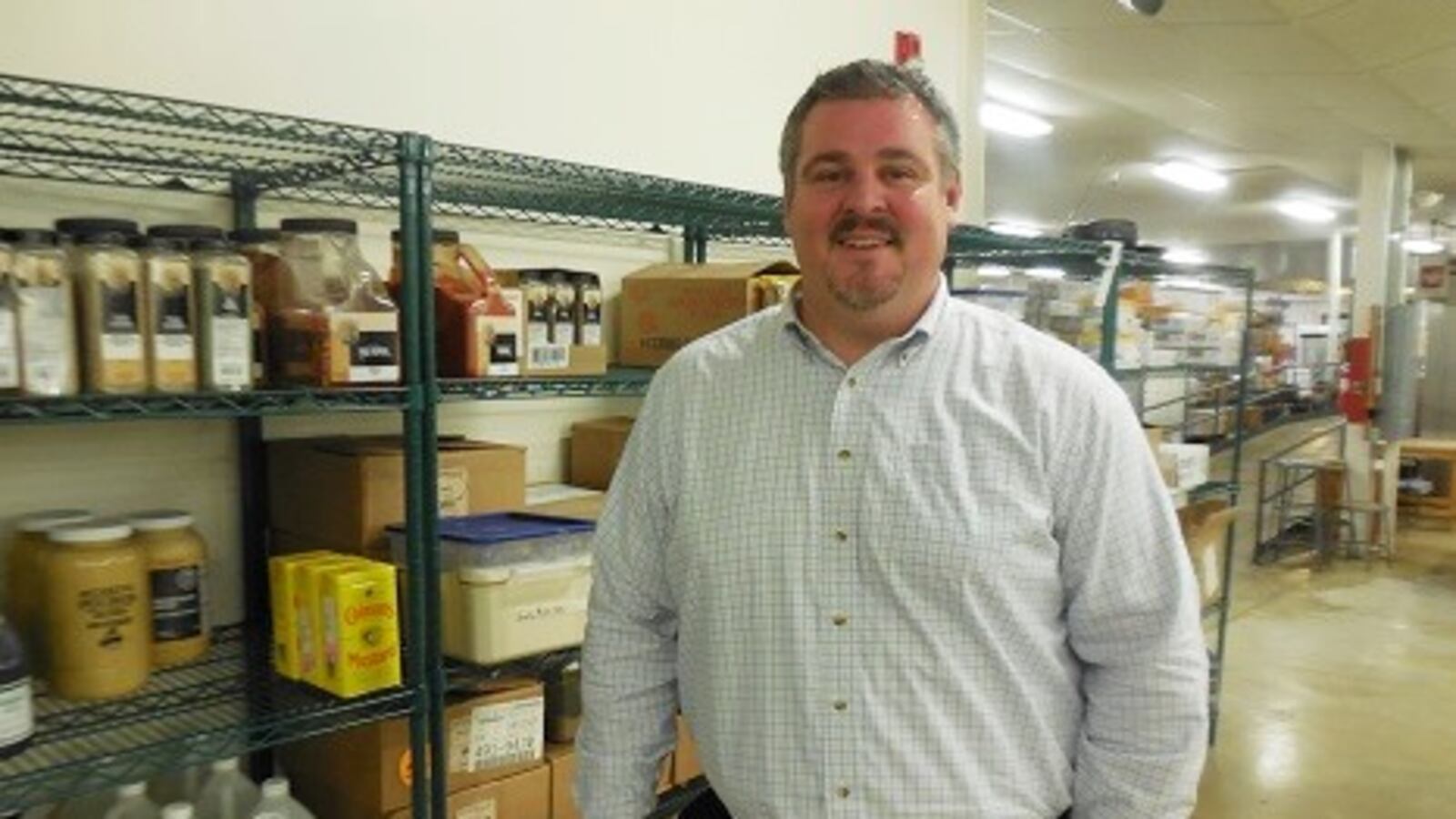Last fall, Denver Public Schools had a zucchini problem.
The district’s school farms had produced a bumper crop of the vegetable, some of which had been damaged by hail. Administrators couldn’t use it all as a fresh ingredient in school meals, but they didn’t want it to go to waste either. That’s when they turned to their northern neighbor, Weld County School District 6, for help.
Under the leadership of Nutrition Service Director Jeremy West, the Weld 6 team grated and packaged 445 pounds of the product, most of which was returned to Denver for later use in zucchini muffins. Those muffins were served to DPS students one day in February.
“It’s great having that kind of partnership,” said Anne Wilson, the Farm to School coordinator for DPS. “Had he not been able to process it, we might not have been able to use it.”
Grating zucchini for students in another community may sound like an odd project for a school district, but it fits perfectly into West’s ambitious plans to turn the district into a food hub that will help put more locally-grown foods on the plates of Weld 6 students as well as those in other districts.
While food hubs come in many forms—often stand-alone wholesale distribution centers–their general purpose is to aggregate, process and redistribute local products to area customers. Such operations can help buyers circumvent some of the problems that otherwise make local purchases challenging. These include connecting with small local growers, cobbling together the necessary quantities of ingredients, navigating storage and delivery logistics, and tackling time-consuming food prep tasks such as washing and chopping hundreds of pounds of produce.
A food hub is hardly typical terrain for a school district, but many think it’s a worthwhile endeavor with the potential to break new ground in the farm-to-school movement. Deborah Kane, national director of the United States Department of Agriculture’s Farm to School program, described West’s food hub plans as unique, then added, “not just unique, but brilliant.”
She said school districts across the country regularly call her program wondering how to source and obtain local products. Often, her answer is, “Try to find a food hub.”
In Weld 6, several factors appear to make the concept a good fit, at least theoretically. In addition to a huge central production kitchen, a rare breed in the school food world, the project complements the district’s recent conversion from heat-and-serve food to scratch-cooked meals.
There’s also the district’s location in one of Colorado’s most bountiful agricultural counties. Weld County has 3,525 farms, more than any other Colorado county, and is second only to Las Animas County in total farm acreage, according to the USDA’s 2012 Agricultural Census.
“We just have a great opportunity in Northern Colorado to really tap into local agriculture,” said West. “If we can’t get it done here, I’m not sure where we can get it done.”
A gradual launch
Conversations about a possible food hub in Weld 6 began about three years ago. West heard about the concept from members of the Colorado Farm to School Task Force and was intrigued. The district had recently re-opened its long dormant central production kitchen, which, in addition to 11,500 square feet of food prep space, had about 20,000 cubic feet of refrigerated storage and 85,000 cubic feet of frozen storage.
“The thought was, ‘How can we make that concept work in a functioning kitchen that already has staff, that already has some infrastructure?’” said West. “That’s why it became attractive to look [at].”
Currently, there are five food hubs in Colorado, according to the USDA’s food hub directory. These include cooperatives in Denver and Fowler and private companies in Colorado Springs, Delta and Fort Collins.
Around the same time West began learning about food hubs, staff at the Weld County Department of Public Health Environment were also becoming interested in the concept. For them, the primary goal was to keep more Weld County products in the region.
Leslie Beckstrom, healthy eating and active living coordinator for the department, said while there were also preliminary conversations with two area food banks about housing the food hub, District 6 ultimately proved to be the most workable option.
“They have three months in the summer, which also coincides with the large growing season here in CO,…when there’s not a whole lot going on,” she said. “There’s some really nice overlapping unused capacity so to speak.”

Initially, customers of the “District 6 Food Hub” will probably include other school districts in northern Colorado, particularly some of the dozen that participate in a group-buying cooperative with Weld 6. But big districts like Denver Public Schools, which has already contracted with West on a couple small processing jobs, are also potential customers. So are institutions such as hospitals, nursing care facilities and food banks.
All told, it’s expected the “District 6 Food Hub” will take about three to five more years to roll out.
“It’s still a toddler,” laughed West.
Krista Garand, supervisor of school nutrition for the Durango school district, knows the feeling. She’s also in the process of taking baby steps toward what she described as a “food hub-like activity” but not a full-fledged food hub.
With the help of a $100,000 USDA grant she’s creating a new receiving center out of some poorly used space next to the high school cafeteria. The new center will give Garand more space to receive and stage local products for both Durango and four neighboring districts that collaborate on farm-to-school programming.
“The potential of it is that we can take larger deliveries, store them properly and trace them a little more closely,” said Garand.
Why local?
Many Colorado school districts, including Weld 6, already seek out local products through their farm-to-school programs, although what’s considered “local” varies widely. A recent national “Farm to School Census” found that 26 percent of respondents defined local products as those from within the state, while 21 percent said they should come from within 50 miles and 13 percent said within 100 miles.
Currently, some districts spend around a quarter of their food budgets on local items, ranging from Palisade peaches to grass-fed beef. In Weld 6, that number is 22 percent, but West hopes it will eventually grow to 50 percent with the help of the food hub.
Some of that local yield may even come from the district itself eventually. This summer West and his staff are working to rehab several unused greenhouses at two of the district’s high schools. There’s also a district-owned plot of land that he has his eye on as well.
The rationale for local food depends on who you ask, but many people believe that just-harvested local items taste better than those picked in far-away fields and shipped long distance. There’s are also arguments around reducing environmental impact and teaching consumers about their region’s seasonal rhythms.
But perhaps one of the biggest reason for buying local is the economic impact.
“Part of Farm to School, especially in Colorado, is honoring the fact that we are an agricultural state number one,” said Julia Erlbaum, a member of the Colorado Farm to School Task Force and founder of Real Food Colorado.
“If you’re buying local ingredients that money is staying in your local environment.”
Beckstrom said some farmers also feel strongly about seeing their products stay local.
“Being able to grow it and sell it to Weld 6 and they know it’s going to feed local kids has that really good heart feel to it,” she said.
There’s also no doubt that demand for local products is growing among consumers, even in school cafeterias. Garand said it’s not unusual for her to hear from parents who plan to send their children through the lunch line on days when local products are featured. These include things like beef, potatoes and wheat that’s incorporated into a pancake.
Testing, testing
As West’s food hub plans unfold, he’s taken on several test projects to help determine what services to offer eventual customers. In addition to the zucchini job for DPS, he also worked with the Windsor school district to convert that district’s surplus frozen butternut squash into a squash soup. In both cases, Weld 6 kept a small amount of the final product as payment.
In addition to the zucchini, Weld 6 ran some tests for DPS to see whether bell peppers could be frozen for use in the district’s stuffed pepper entree. West said such jobs have helped the district not only test out potential products but also given him a sense of how much labor it takes to do complete various processing tasks.
With many districts, even big ones like DPS, lacking the spacious, well-equipped facilities that West has, it’s possible that the Weld 6 Food Hub will offer prepared foods to customers too.
“If they like our chili and we’re making mass quantities of chili for our students, what would it look like for us to also make additional chili that we sell?” asked West.
Making the money work
While the zucchini-for-labor barter system has worked well enough during the initial phase of the food hub’s gradual launch, the long-term plan calls for a dedicated food hub manager and a model that’s financially self-sustaining.
Up until now, grants from the Colorado Health Foundation, the USDA Farm-to-School program and the Colorado Department of Agriculture have helped with planning and start-up activities. And Beckstrom said it’s likely additional grant funds will be needed to create the manager position.
“It’s going to require some seed money,” she said.
Still, Beckstrom is optimistic that with a food hub manager, the operation will eventually turn a profit that can help the hub grow and expand.
“I do think it’s possible,” she said. “That’s why I’m really impressed with Jeremy because he kind of has that entrepreneurial spirit in him and that’s what it’s going to take for a food hub within a school district environment to…thrive.”
Erlbaum said given that a school district’s primary mission is to feed school children, the creation of a food hub in that context necessitates a slow, strategic approach.
“School districts… need to be able to stay within their budget line,” she said.
Erlbaum said among potential revenue sources for a district-based food hub are increased school meal participation, driven by tastier, locally-sourced items, and fees for hub services provided to customers. West said there’s also the potential to lower food costs through volume buying as more districts sign on.
“Our gain is that we get better pricing and more local into our system,” he said.


